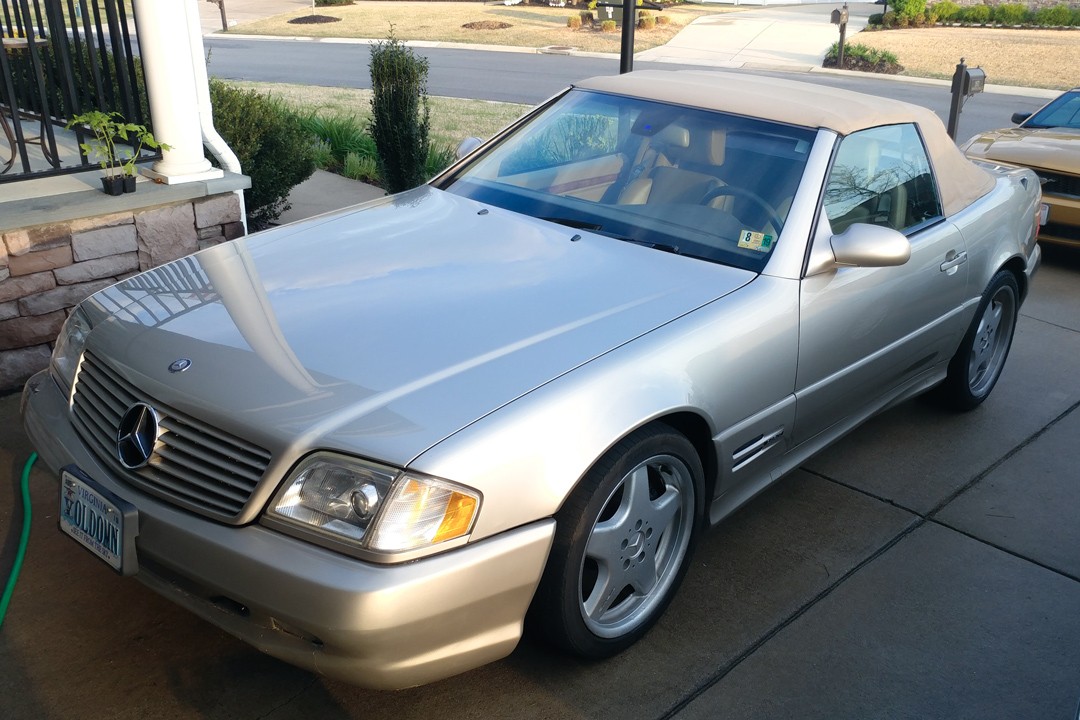The allure of a classic Mercedes-Benz is undeniable, and for many car enthusiasts, the 1999 Mercedes SL500 represents a sweet spot of style, performance, and relative accessibility in the vintage luxury market. One owner’s journey with a 1999 SL500, purchased with over 120,000 miles, provides a compelling look into the realities of owning and maintaining a car of this era, especially when embracing the DIY approach to repairs. This is a story of passion, persistence, and the invaluable automotive education gained from hands-on wrenching.
The Initial Spark: Acquiring a 1999 Mercedes Beauty
The story begins with a classic car enthusiast spotting a 1999 Mercedes SL500 at a relative’s shop. Despite needing work, the inherent beauty of the car was immediately apparent, sparking the thought: “Why not a pretty one?” This sentiment resonates with many drawn to the timeless design of Mercedes-Benz vehicles. The 1999 SL500, just a year older than the new owner, came with 121,000 miles on the odometer, a testament to its previous life and hinting at potential maintenance needs. The decision to purchase was fueled by optimism and a can-do attitude: “if there is a problem, I can deal with that problem.”
The purchase, made with personal savings, marked the beginning of an adventure. The long drive home from New Hampshire to Virginia was punctuated by a stop in Massachusetts, where the first signs of classic car ownership challenges emerged.
Early Roadblocks: Hydraulic Leaks and Engine Misfires in a ’99 SL500
During the Massachusetts visit, a common issue for older convertibles surfaced: the hydraulic system for the convertible top locks began leaking. Hydraulic fluid sprayed, creating a mess, but fortunately, the car’s interior carpeting was spared. This early incident was a gentle introduction to the types of issues that can arise in a 1999 Mercedes SL500, particularly concerning its complex systems.
Further down the road, the engine started misfiring. For someone less familiar with automotive mechanics, this could be a worrying sign. However, the owner soon learned about the robust nature of the Mercedes V8 engine. The M113 engine in the 1999 SL500, with its twin spark plug design (two spark plugs per cylinder), allowed the car to continue running even with a faulty spark plug. This redundancy is a feature of these engines, but the misfire indicated a problem that needed addressing. Upon arriving home and inspecting under the hood, the owner’s curiosity was piqued, leading to the decision to diagnose and repair the issues personally.
DIY Diagnostics and Spark Plug Replacement on the Mercedes SL500
Taking the 1999 Mercedes SL500 to a general repair shop proved to be an insightful experience. It highlighted the importance of specialized knowledge when dealing with older luxury vehicles. The technicians at the shop, accustomed to modern daily drivers, lacked the specific training needed for this vintage Mercedes. This realization, coupled with potential cost concerns, spurred the owner to embrace a DIY approach.
The diagnostic process began with code reading to understand the “check engine” light. Suspecting either coil packs or spark plugs as the culprits for the misfire, the owner embarked on a systematic testing procedure. This involved swapping coil packs, resetting codes, and making multiple trips to AutoZone for code readings. This iterative process, although time-consuming, is a fundamental part of DIY automotive repair. Eventually, the faulty components – two non-firing spark plugs – were identified.
Replacing all spark plugs resolved the immediate misfire issue, and the 1999 SL500 ran smoothly for a period. This initial success boosted confidence and reinforced the value of hands-on learning.
Fuel Injector Frustration and Learning Curve on the ’99 SL500
The journey of maintaining a 1999 Mercedes SL500 was not without its frustrations. Replacing the fuel injectors proved to be a particularly challenging task. Initially, attempting to replace just the O-rings on the existing injectors ran into issues with proper seating and sealing. This highlights the precision required in fuel system components. Ultimately, the solution was to purchase and install new fuel injectors complete with new O-rings.
This fuel injector replacement job became a significant learning experience. During reassembly, minor setbacks like broken bolts occurred, a common occurrence in DIY projects, especially on older vehicles where parts can be brittle or corroded. One instance required drilling out a broken screw, an unwelcome but instructive detour.
Convertible Top Hydraulics: Rebuilding vs. Remanufacturing for a 1999 Mercedes
Returning to the convertible top hydraulics, the owner faced another repair challenge. Rebuilding the hydraulic cylinders for the convertible top seemed like a cost-effective solution initially. While successful in the short term, the owner candidly admits that rebuilding these high-pressure components is not recommended. The difficulty in precisely installing small seals to factory standards led to premature failure. Pressure buildup eventually caused a line to pop, resulting in another hydraulic fluid leak. This experience led to the more reliable, albeit more expensive, solution of ordering and installing remanufactured hydraulic pistons. This episode underscores the importance of choosing the right repair approach, balancing cost with long-term reliability, especially in complex systems like convertible top hydraulics in a 1999 Mercedes SL500.
Brake Overhaul and Dealer Interactions with a Classic Mercedes
The regular maintenance of a 1999 Mercedes SL500 also included brake work. Performing a front and rear brake job led to another challenging situation – a seized caliper pin. Initial attempts to remove it using brute force (hammering) were unsuccessful. Seeking specialized help, the owner took the brake components to a local Mercedes-Benz dealership.
The dealership visit provided a contrasting experience. While modern Mercedes owners were accustomed to dropping off their cars for service and receiving loaner vehicles, the DIY owner arrived with car parts in hand, seeking assistance with a specific issue. This interaction highlighted the different worlds of modern and classic Mercedes ownership. While the dealership staff may have found the request unusual, they ultimately provided the necessary diagnostic help on a few occasions. The owner valued the dealer’s diagnostic expertise, even while performing the actual repairs independently to manage costs.
Tackling the Intake Manifold Leak on the ’99 SL500
One of the most significant DIY undertakings was replacing the intake manifold due to a major air leak. This was described as a “huge job,” involving disconnecting numerous components: coil packs, spark plugs, and vacuum lines. The reassembly process required careful attention to detail and memory to ensure all components were correctly reconnected. The owner recounts the initial engine start after the repair with surprise and relief, expecting potential failures. The successful completion of this complex repair, on the first attempt, was a major accomplishment and a testament to the owner’s growing skills and perseverance.
A minor mishap occurred during a fuel filter replacement, highlighting the importance of safety procedures. Forgetting to depressurize the fuel system resulted in a face full of gasoline – a memorable, if unpleasant, learning experience.
Lessons Learned and Reflections on 1999 Mercedes SL500 Ownership
Reflecting on the ownership experience, the owner offers valuable advice: a project car, especially a Mercedes-Benz with its complex electronics, is not recommended as a first car. The financial aspect of maintaining a 1999 Mercedes SL500 also became apparent. The cost of parts and repairs was a significant factor driving the DIY approach. The owner humorously notes that repairs sometimes kept pace with income.
Despite the challenges and eventual sale of the car, the overriding sentiment is one of positive learning and even nostalgia. “I sold the car but I miss it.” The 1999 Mercedes SL500 ownership journey resulted in a significant acquisition of automotive knowledge and repair skills. From knowing “nothing” initially, the owner progressed to a level of expertise that is deeply rewarding. The experience ignited a passion for automotive repair and a deep understanding of the SL model and cars in general.
Looking ahead, the owner is already considering future classic car projects, hinting at a potential Triumph or a 5-speed 1992 Mercedes 300SL. This story of a 1999 Mercedes SL500 serves as both a cautionary tale and an inspirational narrative for anyone considering venturing into classic Mercedes ownership and DIY car repair. It’s a journey filled with challenges, learning, and the unique satisfaction of keeping a beautiful machine running through personal effort and dedication.

